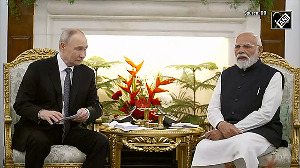There will be no second term for President Kovind and no elevation for Vice President Naidu, reports R Rajagopalan.

Prime Minister Narendra Damodardas Modi faces three political hurdles in the next seven days to seven weeks.
The first litmus test is, of course, the Union Budget being presented next Tuesday.
Since last week Modi has been closeted with Finance Minister Nirmala Sitharaman and finance ministry officials, poring over each and every paragraph in the Budget document.
On Monday, January 24, a final reading was given to the Economic Survey which will be presented in Parliament a week later, that is, January 31.
Insiders say the team has literarily been burning the midnight oil.
The Budget team of Nirmala Sitharaman comprises top secretaries from North Block: T V Somnathan, Expenditure; Ajay Seth, Economic Affairs, Tarun Bajaj, Revenue; Debashish Panda, Financial Services; Tuhin Kanta Pandey, Investment, and the joint secretary, Budget. Modi is acquainted with two of the officials in the Budget team, as they had earlier been posted in his prime minister's office
With coronavirus and the farmers agitation having taken a toll on the government, obviously there are a few references to these in Sitharaman's speech, which Modi is keen to get right.
But the bigger test is to get the narrative right on the Budget, which is what is exercising the team.
The second political crisis for Modi is the five-state assembly elections, results of which will be out on March 10.
Uttar Pradesh, Uttarakhand and Manipur may be an easy catch for the Bharatiya Janata Party, but Punjab and Goa seem a tad cumbersome. If the BJP does not perform well in these states, the cascading effect will lead to Modi's third crisis.
Which, is the Presidential election and the choice of vice president.
Ram Nath Kovind's term ends on July 24 while Vice President Muppavarapu Venkaiah Naidu's term ends soon after, on August 10.
One issue is clear -- there will be no second term for Kovind and no elevation for Naidu.
Even while working on the Budget with his team, Modi has been finalising a few names as possible nominees for President.
What is exercising his mind is that it may not be as easy to get his choice of candidate into Rashtrapati Bhavan as it was in 2017. Reason: Then, the BJP had a comfortable majority with the Shiv Sena, the Akali Dal as part of the National Democratic Alliance.
The All India Anna Dravida Munnetra Kazhagam was also in power in Tamil Nadu, which has since been replaced by the DMK. The Jammu and Kashmir assembly too has been dissolved with the state becoming a Union Territory.
Given all these factors, Modi understandably is under immense pressure to get 55 percentage of the total votes in the electoral college.
Approximately the 735 MPs and 4,128 MLAs in India's legislatures make up the electoral college that votes for the President on a proportional representation basis.
Sensing the potential risk, special emissaries were sent to Kolkata and Bhubaneswar recently to have a preliminary discussion with the Bengal and Odisha chief ministers.
In a recent meeting between Rashtriya Swayamsevak Sangh leaders and BJP President Jagat Prakash Nadda in Hyderabad a broad discussion was held on the presidential election which was followed by two RSS emissaries meeting Modi and Home Minister Amit Anilchandra Shah.
Speculation is that the BJP-RSS have agreed on a few choices for the President's post. While Modi's personal preference extends to a woman President from a southern state, mostly Tamil Nadu, he and the RSS are said to have settled on two governors, who are deemed close to the prime minister.
While the shortlisting of candidates is on at the highest level, a final decision will be taken in the first week of July. What insiders are willing to bet on that it will be a surprise choice.










